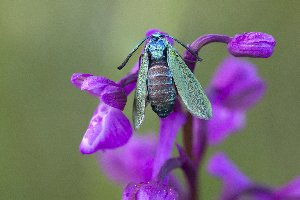 Are you curious about which triggers are responsible for waking up insect pests as the temperatures grow warmer? Do you want to know how to avoid insect-pest infestation in the spring? Here are three things you should know about spring-emerging household pests.
Are you curious about which triggers are responsible for waking up insect pests as the temperatures grow warmer? Do you want to know how to avoid insect-pest infestation in the spring? Here are three things you should know about spring-emerging household pests.
- Why Insects Go Dormant in Winter
Insect pests are coldblooded, or exothermic, creatures. Exothermic pests are unable to generate their own body heat. They function best at temperatures above 50 degrees Fahrenheit. Exothermic insects have several strategies to survive when temperatures fall below freezing.
Some native insects have evolved into species that migrate to warmer climates during winter. Yard pests like grubs burrow deep into the soil. Insects in all life stages from eggs to chrysalides (cocooned insects) to adults are hiding in sheltered areas around your yard and home.
Some places where insects overwinter include:
- Inside timbers and structural framing
- In basements and crawlspaces
- Under wood and rock piles
- Behind tree bark
- Behind house shutters and trim
- Under sinks, shelving, and furniture
- Beneath mulch, turf, and leaves
- On clothing and fabrics
Some insects enter a stage called diapause as the daylight hours shorten in autumn. Insects in diapause cease activity and hibernate, which lowers their metabolic rate by 90 percent or more. Then, the insects survive on stored body fat until the temperatures rise and daylight hours increase in spring.
If insects don’t seek shelter before temperatures grow frigid, ice crystals form inside their bodies in the freezing conditions which are not compatible with life. However, some insects have adapted to provide their own antifreeze. As daylight hours grow shorter, cryoprotectants accumulate in the cells of these insects. The cryoprotectants act like antifreeze to lower the temperature at which the insects’ cells will freeze.
- How Several Common Insects Overwinter
The most common household pests overwinter in various ways. Each species of insect has its own food, water, and other needs which are provided by your home. Here are the winter and spring habits of four types of household pests.
Ants
Ants hunker down in their outdoor nests to survive the winter. The ants congregate in each mound around their queen to keep her warm.
Since the mound entrances and exits are unused during this period, they become sealed off to keep out cold and predators. Active indoor ants in winter have colonized your warm walls or basement.
Flies
Houseflies and many other species of flies are short-lived and cannot survive cold temperatures. The various species survive by hiding in nooks and crannies and laying eggs in rotting garbage, fresh manure, and other nutritious materials.
The maggots eat, pupate, and emerge when the weather grows warm. Cluster and face flies lay eggs in very obscure nooks and crannies of your home and may live indoors throughout the winter.
Cockroaches
Cockroaches aren’t long-lived, but they are prolific breeders. The cockroaches need temperatures above 50 degrees Fahrenheit to survive and reproduce.
If roaches have nested in a cozy area of your home, they will remain active throughout the winter. If the roaches are in a colder spot, they may become dormant or even die.
Spiders
Spiders are arthropods that build up their own antifreeze during cold spells to survive a dip into freezing temperatures. Spider egg sacs can’t survive freezing, so spiders lay them in the hidden spots listed above.
Some species of spider babies hatch and hang out in their protected sacs until the weather is warmer. Other spiders live through winter as young adults and lay their eggs indoors in spring.
One thing is certain when you suddenly begin seeing ants, spiders, and house flies indoors. These insect pests have ended their hibernation periods.
- What Integrated Pest Management Can Do to Reduce Spring Insects
Integrated pest management (IPM) is the solution to repel and eliminate spring-emerging insects. Taking an IPM-based approach means you look at the whole pest problem and address the issues contributing to infestations.
For example, ice dams on the roof contribute to pest infestations in attics. As water drips from the roof into the dark attic, the puddles of water attract moisture-seeking insects who wake up looking for something to drink. These insects then colonize your attic.
If your tub, toilet, or kitchen sink has a leak, expect insects to congregate in the areas around the leaking fixture or in cabinets where leaks hide. Ensure your pipes and drains are free of leaks and convenient access points for insects to exploit.
Cracks around window and door frames are points of entry. Insects also enter via exterior wall openings around cables, vents, and pipes. Ensure that these areas are caulked and sealed when spring arrives.
Clean up debris and trash around your home so pests are not attracted to smelly and hidden places. Keep food and pet kibble in closed, insect-proof containers, so you aren’t inadvertently feeding hungry spring bugs.
Your pest-control professionals have more tips and tricks to help you combat spring-emerging insects in your home. In some cases, pesticides may be used as part of a comprehensive IPM plan. Today’s pesticides are safe and effective for indoor use when applied by trained professionals.
Contact A-Alert Exterminating Service Inc to schedule a thorough inspection of your home or commercial structure. We’ve been helping Chicago-area residents and businesses tackle their pest problems with our individualized services since 1973, and we offer free estimates for all of your pest-control service needs.


